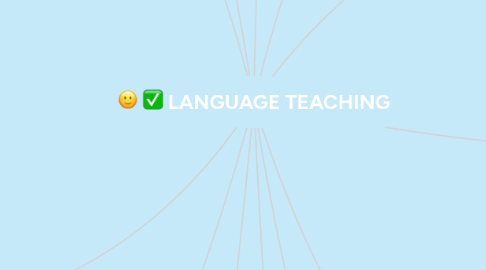
1. Psychotherapy
1.1. T group
1.2. Encounter group
1.3. Analytical
1.4. Gestalt
1.5. Marathon group
1.6. Conjoint family
1.7. Shock
1.8. Client-centered, and narcosis therapy
1.9. Electro-narcosis
1.10. Biochemotherapy
1.11. Analytic psychobiology
2. Approach in teaching
2.1. “Enlightened” teachers
2.1.1. Tailor classes to particular contexts.
2.1.2. approach to language teaching
2.1.2.1. Theoretical rationale
2.1.2.1.1. Underlies everything that happens in the classroom
2.2. Language Pedagogy
2.2.1. Dynamic composite of energies
2.2.1.1. Subject to some “tinkering” as a result of one’s observation and experience
2.3. Research in second language acquisition and pedagogy
2.3.1. Yields findings that are subject to interpretation.
2.4. Interaction
2.4.1. The key to dynamic teaching
3. Research-based principles
3.1. AUTOMATICITY
3.1.1. L2 learning involves a timely movement of the control of a few language forms .
3.2. MEANINGFUL LEARNING
3.2.1. Lead toward better long-term retention than rote learning.
3.2.1.1. Content-centered approaches to language teaching
3.3. THE ANTICIPATION OF REWARD
3.3.1. Anticipated rewards to control behaviours
3.4. INTRINSIC MOTIVATION
3.4.1. Intrensically reward driven by learners.
3.4.1.1. self-rewarding stemed from needs, wants, or desires
3.5. STRATEGIC INVESTMENT
3.5.1. Learner’s own personal “investment” of time, effort...
3.5.1.1. Form of an individualized battery of strategies
3.5.1.1.1. For comprehending and producing the language
3.6. LANGUAGE EGO
3.6.1. Learner´s second identity
3.6.1.1. Create a sense of fragility, defensiveness, and a raising of inhibitions.
3.7. SELF-CONFIDENCE
3.7.1. Self-esteem
3.7.1.1. Lies at the roots of eventual attainment.
3.8. RISK TAKING
3.8.1. Willingness to become “gamblers”
3.8.1.1. Attempt to produce and to interpret language
3.9. THE LANGUAGE–CULTURE CONNECTION
3.9.1. Complex system of cultural customs
3.9.1.1. Values, and ways of thinking, feeling, and acting
3.10. THE NATIVE LANGUAGE EFFECT
3.10.1. Effects on the production and comprehension of the new language
3.10.1.1. Mother tongue influences L2 learning
3.11. INTERLANGUAGE
3.11.1. Successful interlanguage development from feedback
3.12. COMMUNICATIVE COMPETENCE
3.12.1. Components: organizational, pragmatic, strategic, and psychomotoric.
3.12.1.1. Goals achieved by giving attention to language use, fluency, authentic language and contexts, and to students' needs.
4. Diagnosis
4.1. Situational needs
4.1.1. Country of the institution, socioeconomic background, educational background
4.1.2. language proficiency
4.1.2.1. Motivation
4.1.2.1.1. Language ego issue
4.1.3. relationship between the target language and the native culture
4.1.4. Multiphase approach to a language course.
4.1.4.1. Courses of study teaching or, better, sets of learning experiences
4.1.4.1.1. Designed to target learner needs
4.1.5. Teaching techniques (Crook & Chaudron, 1991)
4.1.5.1. language teaching techniques
4.1.5.1.1. Drills, dialogues, reading aloud, display questions/answers, etc
5. Treatment
5.1. Designed to target learner needs
5.1.1. Range from controlled (drills, dialogues, reading aloud, display questions/answers, etc.)
5.2. Suggestion of strategic investment
5.2.1. LOWER INHIBITIONS
5.2.2. ENCOURAGE RISK TAKING
5.2.3. BUILD STUDENTS’ SELF-CONFIDENCE
5.2.4. HELP STUDENTS DEVELOP INTRINSIC MOTIVATION
5.2.5. PROMOTE COOPERATIVE LEARNING
5.2.6. ENCOURAGE STUDENTS TO USE RIGHT-BRAIN PROCESSING
5.2.7. PROMOTE AMBIGUITY TOLERANCE
5.2.8. HELP STUDENTS USE THEIR INTUITION
5.2.9. GET STUDENTS TO MAKE THEIR MISTAKES WORK FOR THEM
5.2.10. GET STUDENTS TO SET THEIR OWN GOALS
6. Research-based techniques
6.1. Shift from Teacher-centered to student centered
6.2. Let the kids have choices
6.3. Collaboration, communication, critical thinking, creativity.
7. For inspiring students of the future
7.1. Relationship
7.1.1. Opportunity to listen to their thinking
7.1.2. Teacher’s love for the subject and passion for the subject
7.1.3. The teacher’s genuine love for the kids, decisional love, it motivates and inspires
7.1.4. CARING
7.1.4.1. The most effective, powerful, most inspiring way of teaching
7.1.5. Most important
7.1.5.1. How do we motivate? How do we inspire?
7.1.5.2. Allow kids to involve themselves in the classroom.
8. Hierarchical elements
8.1. Approach
8.1.1. Set of assumptions dealing with the nature of language, learning, and teaching.
8.2. Methods
8.2.1. Defined as an overall plan for systematic presentation of language based on a selected approach.
8.2.1.1. Prabhu (1990) thought of method as both classroom activities and the theory that informs them.
8.3. Techniques
8.3.1. Specific classroom activities consistent with a method, and therefore in harmony with an approach.
9. The Art of Teaching and Learning Foreign Languages (1880)
9.1. Direct Method
9.2. Audiolingual Method (1940)
9.3. Cognitive-Code Learning Method (1940)
10. The“Spirited seventies”
10.1. The “designer” methods
10.1.1. Community Language Learning
10.1.2. The Silent Way,
10.1.3. Suggestopedia,
10.1.4. Total Physical Response
11. Assessment
11.1. Formative evaluation
11.2. Performance-based assessment
11.3. Portfolio development
11.4. Oral production inventories
11.5. Cooperative student-student techniques
11.6. Testing rubrics
12. Mediated learning experience
12.1. Mediating agents
12.1.1. Organizes accurate stimulus
12.1.2. Guided by intentions, culture, endeavor
12.2. Replaces the classical notion of intelligence
12.2.1. Other factors that affect academic performance
12.2.1.1. Affective, motivationals, social, environmental, etc.
